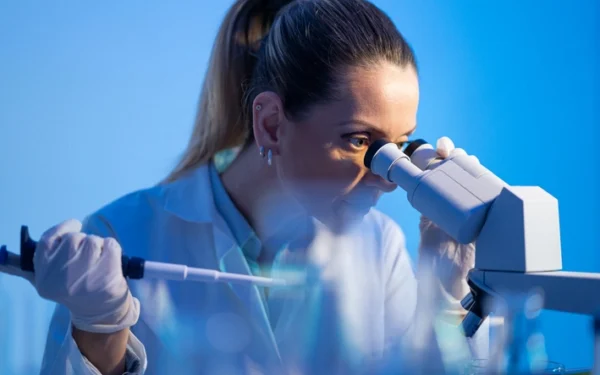Artificial intelligence (AI) has the potential to revolutionize the use of data in science laboratories. By leveraging machine learning algorithms, AI can help scientists analyze data faster, identify patterns and trends, and make more accurate predictions. Here are four specific topics, with examples in each case, of how AI can be used in science laboratories:
Drug Discovery
AI can be used to help identify new drug candidates by analyzing large datasets of chemical compounds and predicting their potential efficacy. By training machine learning algorithms on existing chemical data, AI can identify patterns and predict which compounds are most likely to be effective, reducing the time and cost of drug discovery.
- AI can measure the binding affinity of a drug by considering the features or similarities of the drug and its target [1].
- AI can analyze the Drug Information Bank to predict therapeutic potential, identify drug targets, evaluate pharmacokinetics, and screen compounds [2].
- Virtual screening uses AI-based algorithms to find potential lead molecules among millions [2].
- AI can automate chemical syntheses, making the process faster and more efficient [2].
- AI can classify various cell types, aiding in the discovery of new targets for drug development [2].
- AI can be used for target selection and validation, compound screening, and lead optimization [2].
- AI can take in vivo-relevant properties of drugs into account for better drug discovery approaches in the future [3].
References:
[1] Artificial intelligence in drug discovery and development
[2] 4 Application Areas of Artificial Intelligence in Drug Discovery
[3] Artificial intelligence in drug discovery: what is realistic…
Predictive Analytics
AI can be used to analyze large datasets of experimental data and make predictions about future outcomes. For example, AI could be used to predict the outcome of a chemical reaction based on the input parameters, identifying the optimal conditions for a desired outcome. Here are some specific predictive analytics use case examples:
- AI-powered lab management systems can predict equipment failures, allowing for proactive maintenance and reducing downtime.
- Predictive analytics can be used to forecast inventory needs, ensuring that the lab has the necessary supplies on hand.
- AI can analyze historical data to predict future trends and patterns, allowing for better decision-making in the lab.
- Predictive analytics can be used to forecast the success of experiments, helping researchers prioritize their efforts.
- AI can predict the optimal conditions for an experiment, reducing the need for trial and error.
Quality Control
AI can be used to monitor and analyze data from laboratory instruments in real-time, identifying potential issues before they become problems. For example, AI could be used to monitor temperature and humidity levels in a laboratory, alerting scientists to any deviations from optimal conditions. Here are some specific quality control use case examples:
- AI can automatically identify and analyze defects in manufacturing processes, allowing for quick identification and correction of quality control issues.
- AI can monitor instrument performance and flag any deviations from optimal conditions, ensuring that results are accurate and consistent.
- AI can predict the likelihood of batch failures based on historical data, allowing for preemptive action to be taken.
- AI can automate the process of identifying and removing outliers in data, ensuring that only high-quality data is used for analysis.
- AI can analyze data from multiple sources to identify correlations and patterns, allowing for better decision-making and more effective quality control measures.
Data Integration
AI can be used to integrate data from multiple sources, including laboratory instruments, databases, and external sources. By analyzing this data in real-time, AI can provide scientists with a more comprehensive view of their experiments, allowing them to make more informed decisions. Here are some specific data integration use case examples:
- AI can integrate data from multiple sources, such as laboratory instruments, databases, and external sources, to provide a more comprehensive view of experiments.
- AI can identify patterns and trends in large datasets, allowing researchers to make more informed decisions.
- AI can analyze historical data to predict future trends and patterns, enabling more accurate forecasting and planning.
- AI can automate the process of data cleaning and standardization, ensuring that all data is consistent and usable.
- AI can integrate data from different stages of the research process, from initial experimentation to quality control and final analysis, providing a complete picture of the data.
Conclusion
AI has the potential to revolutionize the use of data in science laboratories, allowing scientists to analyze data faster, identify patterns and trends, and make more accurate predictions. From drug discovery to quality control, AI can be used in a wide range of laboratory applications, providing scientists with new insights and enabling them to achieve their research goals more efficiently.





